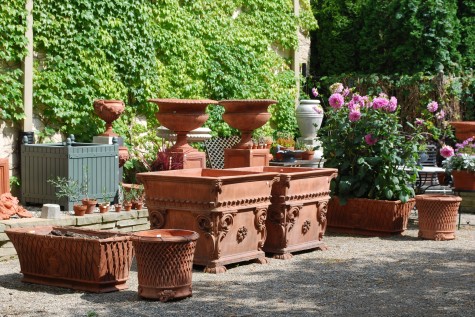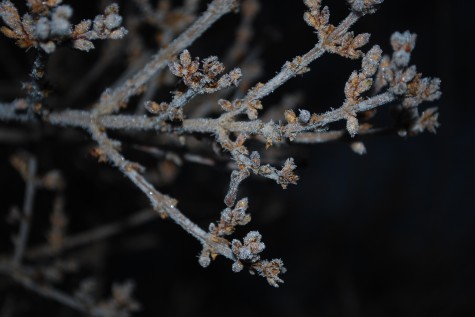 Hoarfrost is simply frozen dew. Though this form has none of the romance of a dewy June morning, it is lovely. If we are going to get hoarfrost, it usually appears in January, after a rain. We have had intermittent rain for several days, with freezing temperatures overnight; this morning was 24 degrees. As a result, everything was coated in fine white ice crystals barely visible in the fog. This made for a beautiful January morning.
Hoarfrost is simply frozen dew. Though this form has none of the romance of a dewy June morning, it is lovely. If we are going to get hoarfrost, it usually appears in January, after a rain. We have had intermittent rain for several days, with freezing temperatures overnight; this morning was 24 degrees. As a result, everything was coated in fine white ice crystals barely visible in the fog. This made for a beautiful January morning.
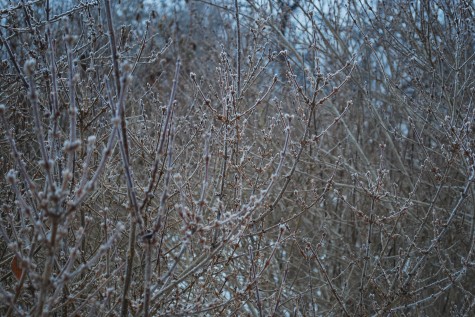 The frost on these forsythia branches was very subtle-just enough to greatly soften their appearance. Deciduous shrubs in winter have a quiet beauty all their own. The winter is one of the best times to evaluate shrubs for your garden; their winter appearance should be as important a factor in your selection as their summer dress. The frost in particular makes their shape and habit clear.
The frost on these forsythia branches was very subtle-just enough to greatly soften their appearance. Deciduous shrubs in winter have a quiet beauty all their own. The winter is one of the best times to evaluate shrubs for your garden; their winter appearance should be as important a factor in your selection as their summer dress. The frost in particular makes their shape and habit clear.
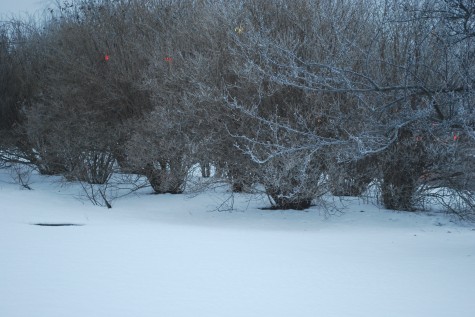
If I had property of size, I might plant honeysuckle. They have a fairly uninteresting summer presence, but their dense thicket of dark brown stems are very attractive from a distance in the winter. Growing robustly to 10-15 feet tall, they can screen a poor view as well or better than an evergreen. They only need room, and lots of it. Large shrubs that have been pruned poorly, or pruned to fit a small space tell that story in the winter.
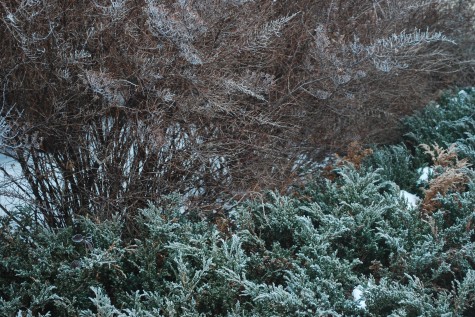
These spirea in my neighborhood are never pruned at the right time of year. This person invariably prunes them only a few weeks before they flower, and never, as he should, right after they finish flowering. The benefit to me-the long and lacy spent flower stems are lovely in the winter. Luckily he does no pruning on his junipers; they have a naturally loose and pleasing shape. The frosty tips reveal the shape clearly; if you like the winter shape of any tree or shrub, you are doing something right.
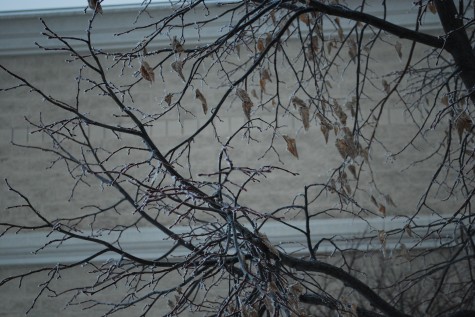 Trees can be a nuisance to prune, as most of the activity is a long way from the ground. But the winter silhouette will make clear where a branch could be cleaned up, or headed back, in a good and beautiful way. The stub pruned branch in the middle of this picture-I would take it all the back to the big branch. Whatever shape you are trying to encourage makes itself known now.
Trees can be a nuisance to prune, as most of the activity is a long way from the ground. But the winter silhouette will make clear where a branch could be cleaned up, or headed back, in a good and beautiful way. The stub pruned branch in the middle of this picture-I would take it all the back to the big branch. Whatever shape you are trying to encourage makes itself known now.
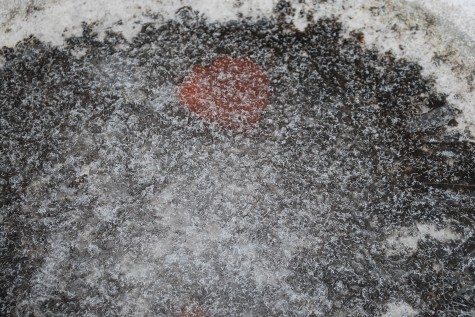 The hoarfrost sticks to ice as well as any other surface. A single fall leaf frozen in the ice may be a melancholy reminder of the dormant garden, but the colors, textures and shapes here are quite beautiful.
The hoarfrost sticks to ice as well as any other surface. A single fall leaf frozen in the ice may be a melancholy reminder of the dormant garden, but the colors, textures and shapes here are quite beautiful.
 Every bark has its own brown. The crabapples are grey and black, the forsythias a warm yellow brown. Choosing shrubs and trees for their bark has its winter rewards. Now is the perfect time to look at bark; is a dominant feature of the winter landscape. With every bit as much variation as leaves or flowers, there is actually a lot to see.
Every bark has its own brown. The crabapples are grey and black, the forsythias a warm yellow brown. Choosing shrubs and trees for their bark has its winter rewards. Now is the perfect time to look at bark; is a dominant feature of the winter landscape. With every bit as much variation as leaves or flowers, there is actually a lot to see.
 The field next door was breathtaking this morning. The white frost, the blue white snow, and the dark rock may lack the romance of May, but there is this alternate garden universe which is worth seeing. Though not in active grown, woody plants, and the remains of perennial plants have a lot to say, even in the winter.
The field next door was breathtaking this morning. The white frost, the blue white snow, and the dark rock may lack the romance of May, but there is this alternate garden universe which is worth seeing. Though not in active grown, woody plants, and the remains of perennial plants have a lot to say, even in the winter.

The hoarfrost variegation on the boxwood had disappeared by 9 am. I am glad I did not miss it.

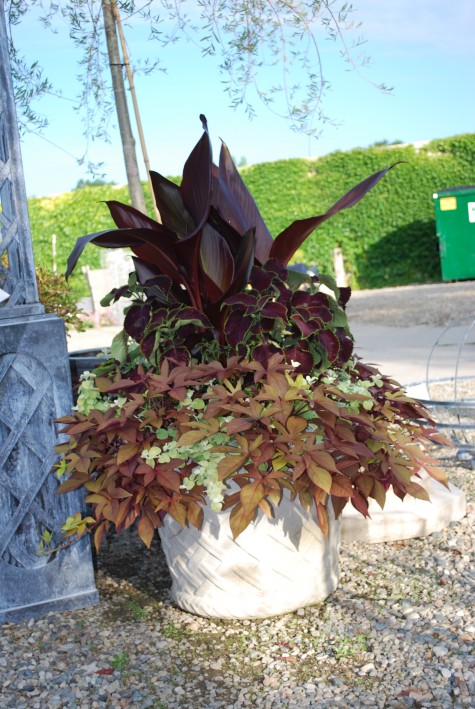
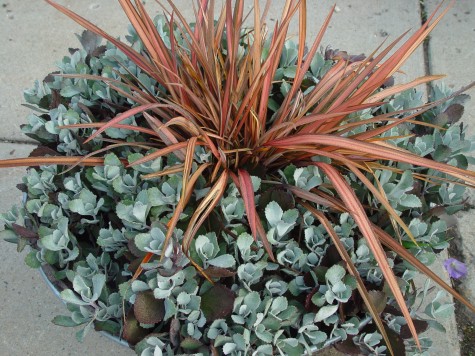
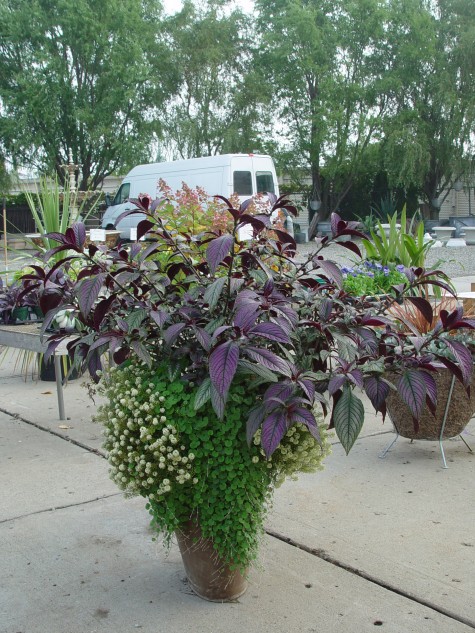
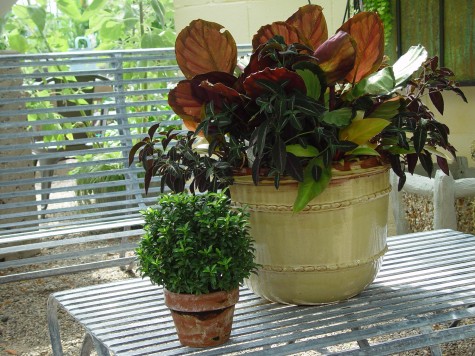

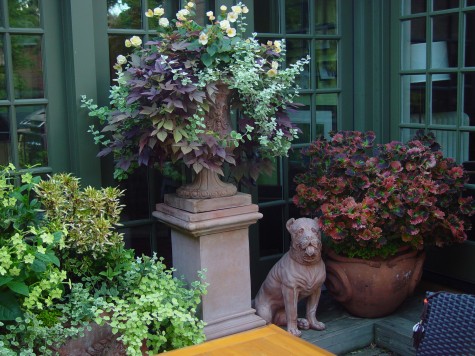
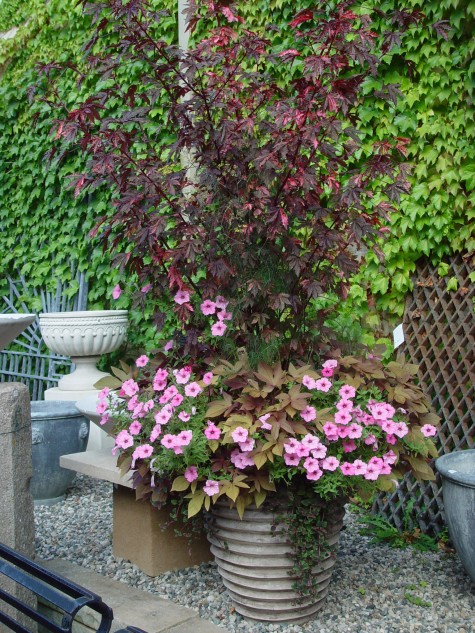
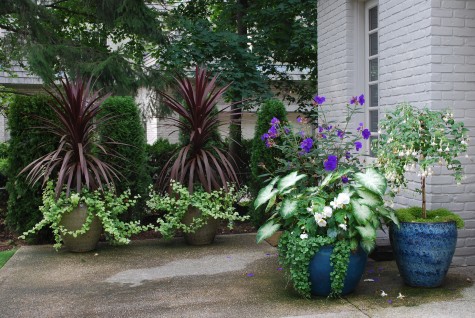
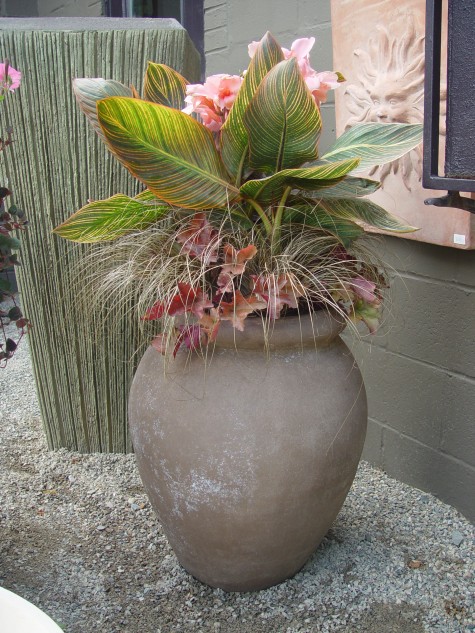
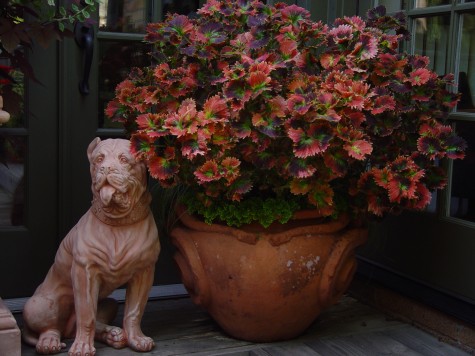
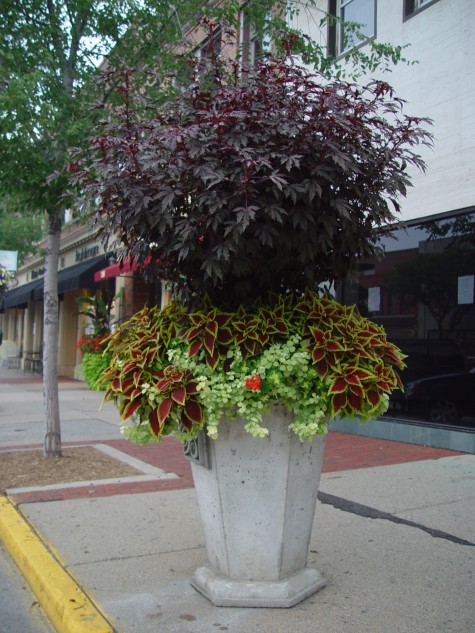
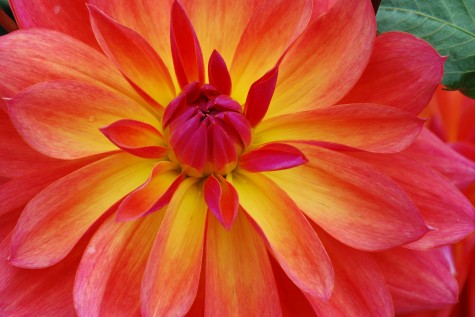 Thank heavens for red and yellow; I would not want to do without orange in my garden. This picture of an orange dahlia tells the entire story of what happens when red, in this case a very blue or carmine red, gets mixed with yellow. Fireworks. Daylilies are a staple source of orange in a perennial garden. If a daylily is not yellow, there is orange lurking in the petals in one form or another. Even a drift of the subdued daylily Ruffled Apricot can warm the eye from a distance. Orange is visually effective in even the smallest doses; is it not interesting how easy it is to spot the one lone blooming butterfly weed in the entire field? Even those who are not big fans of orange in theory can fall for an oriental poppy that color. Poppies look like they ought to be orange.
Thank heavens for red and yellow; I would not want to do without orange in my garden. This picture of an orange dahlia tells the entire story of what happens when red, in this case a very blue or carmine red, gets mixed with yellow. Fireworks. Daylilies are a staple source of orange in a perennial garden. If a daylily is not yellow, there is orange lurking in the petals in one form or another. Even a drift of the subdued daylily Ruffled Apricot can warm the eye from a distance. Orange is visually effective in even the smallest doses; is it not interesting how easy it is to spot the one lone blooming butterfly weed in the entire field? Even those who are not big fans of orange in theory can fall for an oriental poppy that color. Poppies look like they ought to be orange.  Orange exists in a garden in other forms besides flowers. Interior arborvitae needles turn as rusty orange as this old fountain before they are shed. Iron garden ornament, and terra cotta pots are an excellent source of orange in the garden. I have had many people tell me their favorite season in Michigan is the fall-and I hear no grumbling about all the orange. What group of plants have you ever seen planted in a terra cotta pot that looked bad as a result of that orange pot? Orange in big brilliant doses is not for the faint of heart, but a little orange zest never hurt any garden.
Orange exists in a garden in other forms besides flowers. Interior arborvitae needles turn as rusty orange as this old fountain before they are shed. Iron garden ornament, and terra cotta pots are an excellent source of orange in the garden. I have had many people tell me their favorite season in Michigan is the fall-and I hear no grumbling about all the orange. What group of plants have you ever seen planted in a terra cotta pot that looked bad as a result of that orange pot? Orange in big brilliant doses is not for the faint of heart, but a little orange zest never hurt any garden.  The trim on my house is painted turtle green. I suppose I chose the color as much for the name as the color. Olive drab would have been an equally believable name; this planting of solenia orange begonias in a dusty peachy orange Italian terra cotta pot makes that olive paint color come to life. The variegated licorice makes reference to the bluish green of the begonia foliage; the lime creeping jenny underneath keeps everything up top cooking.
The trim on my house is painted turtle green. I suppose I chose the color as much for the name as the color. Olive drab would have been an equally believable name; this planting of solenia orange begonias in a dusty peachy orange Italian terra cotta pot makes that olive paint color come to life. The variegated licorice makes reference to the bluish green of the begonia foliage; the lime creeping jenny underneath keeps everything up top cooking. 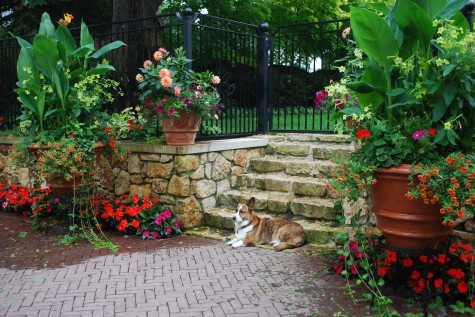 I did all of my summer flowers in some combination of orange, and carmine, or red-violet. It did scare the heck out of me once I got everything planted. I was worried to would be more excitement than I really wanted. No doubt these warm colors looked good with my yellow/orange stone, and the sandy yellow brick on my house-not to mention the purple/brown brick of my drive. The one year I planted all white flowers just didn’t work. Though Howard’s coat color is formally known as red brindle, he is a most handsome orange and white.
I did all of my summer flowers in some combination of orange, and carmine, or red-violet. It did scare the heck out of me once I got everything planted. I was worried to would be more excitement than I really wanted. No doubt these warm colors looked good with my yellow/orange stone, and the sandy yellow brick on my house-not to mention the purple/brown brick of my drive. The one year I planted all white flowers just didn’t work. Though Howard’s coat color is formally known as red brindle, he is a most handsome orange and white.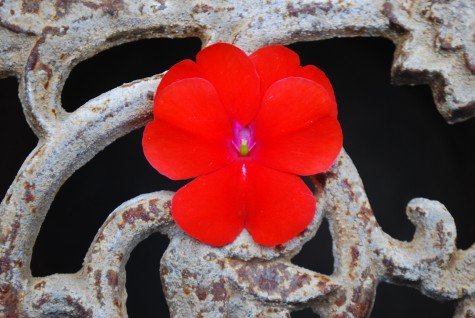 Though this Sonic orange New Guinea impatiens flower might make your eyes hurt, I find it easier to use in a garden than a blue red. I have a client that has been planting orange and white in her garden for many years. What many thought was eccentric fifteen years ago looked very fashionable and sophisticated this year. Funny, that.
Though this Sonic orange New Guinea impatiens flower might make your eyes hurt, I find it easier to use in a garden than a blue red. I have a client that has been planting orange and white in her garden for many years. What many thought was eccentric fifteen years ago looked very fashionable and sophisticated this year. Funny, that.  Pink and orange together is such a lively and happy combination. Both Emilio Pucci and Lily Pulitzer based fashion empires on fearlessly friendly color combinations like this. If I only have the chance to make one point about color, it would be this. In isolation, a color may not appeal to you. But the real impact of color is about color relationships. What colors do for each other is more important than any color itself. It never hurts to take some of what colors you have when shopping for plants. Whatever your ideas might be about color, let your eyes make the decisions.
Pink and orange together is such a lively and happy combination. Both Emilio Pucci and Lily Pulitzer based fashion empires on fearlessly friendly color combinations like this. If I only have the chance to make one point about color, it would be this. In isolation, a color may not appeal to you. But the real impact of color is about color relationships. What colors do for each other is more important than any color itself. It never hurts to take some of what colors you have when shopping for plants. Whatever your ideas might be about color, let your eyes make the decisions.